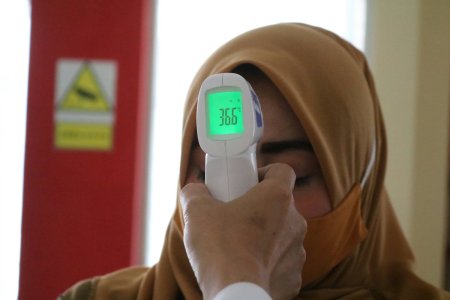7 fever myths you still believe—doctors set the record straight!
By
Aubrey Razon
- Replies 0
Flu season is hitting hard, bringing with it one of the most common symptoms—fever. Many long-held beliefs about fever might not be as true as you think.
Are you falling for these seven fever myths?
As the flu season grips the United States with a tenacity not seen in nearly a decade, with over 29 million cases reported by the Centers for Disease Control and Prevention, it's time to talk about one of its hallmark symptoms: fever.
At The GrayVine, we understand that our readers are looking for reliable information to navigate their health concerns, especially when it comes to common misconceptions that could affect their well-being.
Today, we're tackling the heat of the matter by debunking seven fever myths that have persisted through the years.

Dr. David Cutler, a family medicine specialist, explains that the widely accepted average of 98.6 degrees Fahrenheit is based on outdated research.
Modern studies suggest that a “normal” body temperature might actually be closer to 97.9 degrees.
So, don't be alarmed if your resting temperature is a little lower than what you've always been told.
Dr. Henry Young, an emergency medicine expert, reminds us that if your baseline temperature is naturally lower, your threshold for fever could be different.
Dr. Young emphasizes the importance of nourishing your body to fight off illness.
While your appetite might wane during a fever, it's crucial to maintain fluid intake to compensate for losses from sweating, which can occur without you even realizing it.
Focus on water, sports drinks, and fruit juices, and avoid alcohol and caffeine, which can dehydrate you further.

On the contrary, a fever is your body's natural defense mechanism in action.
It indicates that your immune system is working to combat an infection by creating an environment less hospitable to viruses and bacteria.
Most fevers are harmless, but if temperatures soar to 105 or 106 degrees, it's time to seek medical attention.
They can make you feel more comfortable while your body does the heavy lifting in fighting the infection.
If you're managing symptoms with fever-reducing medications and don't feel too unwell, you may not need to rush to the doctor.
However, if your fever persists, causes confusion, or is accompanied by other severe symptoms, medical consultation is crucial.
This is especially true for vulnerable populations, including the very young, the elderly, or those with weakened immune systems.
They're particularly useful for quickly checking temperatures without causing discomfort, especially in children.
Just be sure to follow the manufacturer's instructions and take multiple readings for consistency.

If you're feeling relatively well, you might not need to treat a mild fever. However, if you're uncomfortable, over-the-counter medications can help you feel better.
Regardless, staying hydrated and resting are key to recovery.
Remember, while a fever can be a good sign that your body is fighting back, it's essential to monitor your symptoms and seek medical advice when necessary.
Let's put these fever myths to rest and focus on the facts for a healthier flu season.
 Have you ever fallen for any of these fever myths? Do you have any tips for managing fevers at home?
Have you ever fallen for any of these fever myths? Do you have any tips for managing fevers at home?
Share your experiences and questions in the comments below. Let's continue to learn from each other and keep our community healthy and informed.
Are you falling for these seven fever myths?
As the flu season grips the United States with a tenacity not seen in nearly a decade, with over 29 million cases reported by the Centers for Disease Control and Prevention, it's time to talk about one of its hallmark symptoms: fever.
At The GrayVine, we understand that our readers are looking for reliable information to navigate their health concerns, especially when it comes to common misconceptions that could affect their well-being.
Today, we're tackling the heat of the matter by debunking seven fever myths that have persisted through the years.

Fevers indicate that the body's immune system is actively fighting an infection. Image source: Polina Tankilevitch/Pexels.
Myth 1: 98.6 degrees Fahrenheit is the standard “normal” body temperature
The truth is, body temperature isn't a one-size-fits-all number.Dr. David Cutler, a family medicine specialist, explains that the widely accepted average of 98.6 degrees Fahrenheit is based on outdated research.
Modern studies suggest that a “normal” body temperature might actually be closer to 97.9 degrees.
So, don't be alarmed if your resting temperature is a little lower than what you've always been told.
Myth 2: A fever isn't a fever unless it's above 100.4 Degrees Fahrenheit
While the medical community generally defines a fever as a temperature at or above 100.4 degrees, individual variations mean you could experience feverish symptoms even with a lower reading.Dr. Henry Young, an emergency medicine expert, reminds us that if your baseline temperature is naturally lower, your threshold for fever could be different.
Myth 3: You should “starve a fever”
This old adage is not only outdated but potentially dangerous.Dr. Young emphasizes the importance of nourishing your body to fight off illness.
While your appetite might wane during a fever, it's crucial to maintain fluid intake to compensate for losses from sweating, which can occur without you even realizing it.
Focus on water, sports drinks, and fruit juices, and avoid alcohol and caffeine, which can dehydrate you further.
Myth 4: A fever is a bad sign

Individuals with normally lower body temperatures might experience feverish symptoms even at lower readings. Image source: Mufid Majnun/Unsplash.
On the contrary, a fever is your body's natural defense mechanism in action.
It indicates that your immune system is working to combat an infection by creating an environment less hospitable to viruses and bacteria.
Most fevers are harmless, but if temperatures soar to 105 or 106 degrees, it's time to seek medical attention.
Myth 5: Over-the-counter medications can cure a fever
Medications like acetaminophen or ibuprofen can alleviate discomfort associated with fever, such as body aches and fatigue, but they don't treat the underlying cause.They can make you feel more comfortable while your body does the heavy lifting in fighting the infection.
Myth 6: You should always call a doctor when you have a fever
Not necessarily.If you're managing symptoms with fever-reducing medications and don't feel too unwell, you may not need to rush to the doctor.
However, if your fever persists, causes confusion, or is accompanied by other severe symptoms, medical consultation is crucial.
This is especially true for vulnerable populations, including the very young, the elderly, or those with weakened immune systems.
Myth 7: No-touch thermometers aren't accurate
No-touch thermometers gained popularity during the COVID-19 pandemic, and while they may not always be as precise as oral thermometers, they can still be effective if used correctly.They're particularly useful for quickly checking temperatures without causing discomfort, especially in children.
Just be sure to follow the manufacturer's instructions and take multiple readings for consistency.

Over-the-counter medications like acetaminophen or ibuprofen can alleviate discomfort associated with fevers. Image source: Tima Miroshnichenko/Pexels.
Understanding fevers: The bottom line
A fever is a clear sign that your body is fighting an infection, but it's important to differentiate between the fever itself and its cause.If you're feeling relatively well, you might not need to treat a mild fever. However, if you're uncomfortable, over-the-counter medications can help you feel better.
Regardless, staying hydrated and resting are key to recovery.
Remember, while a fever can be a good sign that your body is fighting back, it's essential to monitor your symptoms and seek medical advice when necessary.
Let's put these fever myths to rest and focus on the facts for a healthier flu season.
Key Takeaways
- Doctors are setting the record straight on common fever myths during a severe flu season in the US with at least 29 million cases reported.
- A fever is acknowledged medically when a body temperature reaches or exceeds 100.4 degrees Fahrenheit, but individuals with normally lower body temperatures might experience feverish symptoms even at lower readings.
- Fevers indicate that the body's immune system is actively fighting an infection, and most fevers are not dangerous unless they reach extremely high levels.
- Over-the-counter medications like acetaminophen or ibuprofen can alleviate discomfort associated with fevers but do not combat the underlying viral or bacterial infection causing the fever.
Share your experiences and questions in the comments below. Let's continue to learn from each other and keep our community healthy and informed.






